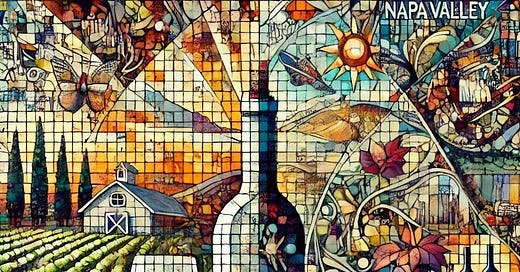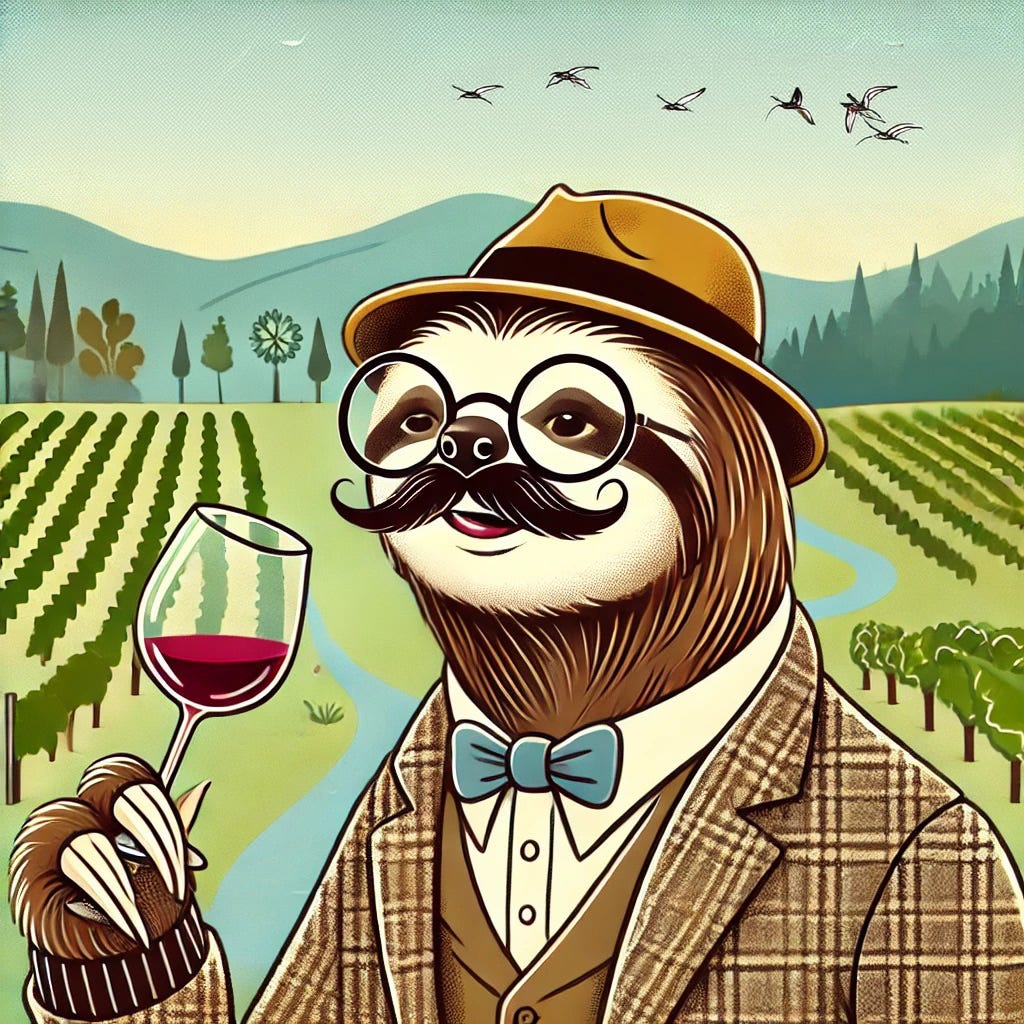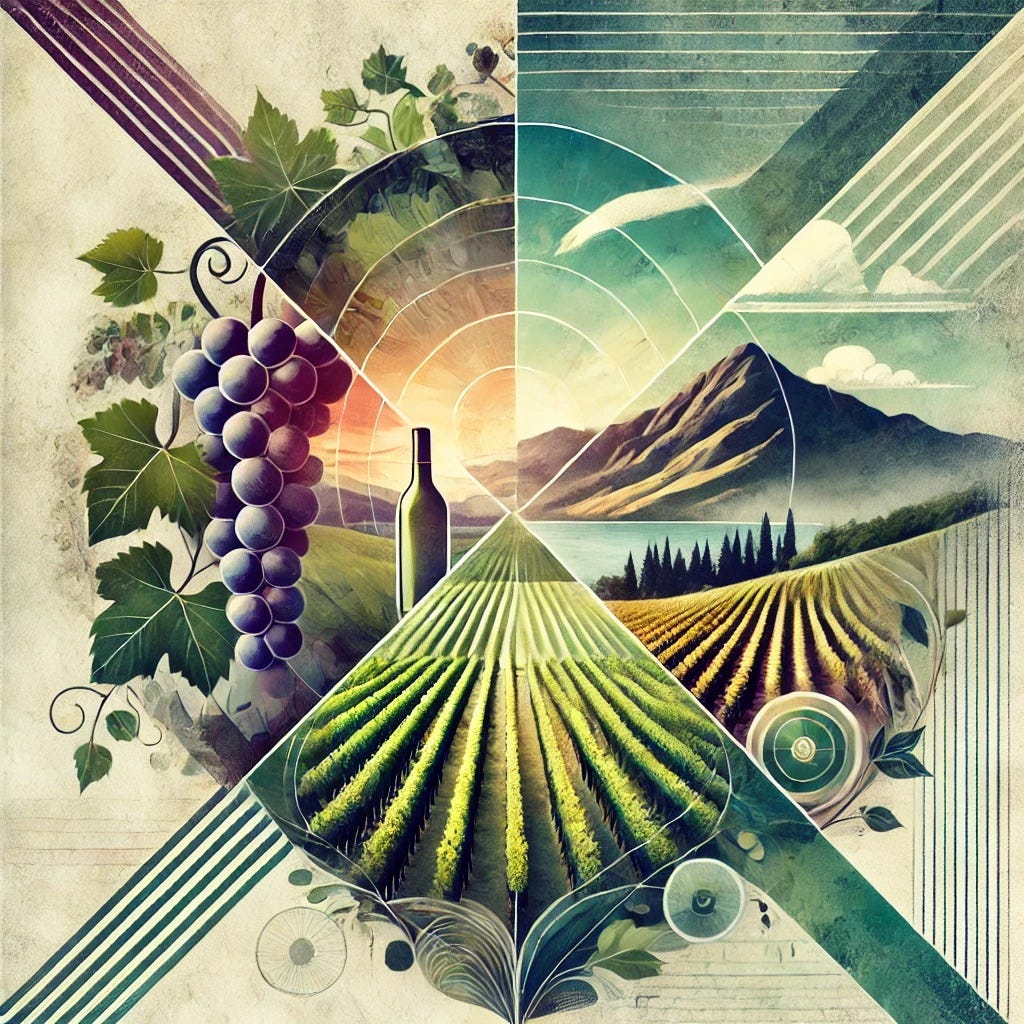NAPA VALLEY, Calif. — In the early 1990s, a helicopter flew over two cyclists tooling north along a ribbon of Pacific Ocean-adjacent highway. On my television set a narrator cooed glowingly of bicycling in what he called the idyllic “wine country of Napa Valley.” Uh, ocean-adjacent? I recognized that the flyover was the western edge of Sonoma County, just west of the Russian River Valley.
It is understandable that someone who has never visited Northern California would make such a blunder. Wine Country, the phrase that keeps on giving, has been identified by most Americans as Napa Valley for 70 years. And what Napa has achieved will never be surpassed, at least in terms of wine quality, history and — above all — image.
It was in the 1880s when Napa, spurred by French investors, first began to realize a unique destiny with the production of some reportedly excellent wines, notably cabernet sauvignon. The valley later developed quite a reputation for petite sirah and zinfandel and on into the 1960s and ’70s with chardonnay and sauvignon blanc.
Only three events slowed this area down in its quest for world-class status in wine. They were the twin phylloxera infestations of the 1880s and 1980s and the failed national experiment called Prohibition. Together those episodes cost Napa roughly a century in its inevitable drive toward worldwide recognition for vinous greatness. What it has achieved can never be besmirched.
In fact, Napa’s unbelievable success as “America’s Wine Country” and as a staging ground for the launching of a wine culture has yielded some remarkable and eye-catching achievements. One such accomplishment, which may not be evident to most people, is the almost complete obliteration of other areas of California that also have achieved wine greatness. Napa’s successes overshadow everything else. Others may make fine wine but with none of the acclaim.
One nearby example should suffice to prove this point. Sonoma County has had the bad luck of always being No. 2 in the eyes of wine-lovers, some of whom may be aware of the excellence of its wines but who have continuously been bombarded with a singular message: Napa is where it’s happening.
A case in point about the confusion: More than one U.S. restaurant wine list has proclaimed its long, happy relationship with and support for Jordan Vineyards, whose cabernet sauvignon has for decades been one of the nation’s most popular cabs. One reason is that it was designed to go with food. And many of these Jordan-supportive restaurants say to patrons that Jordan cab is as good as it is because it’s from Napa Valley. Oops. It is from Alexander Valley, a northerly area in Sonoma County.
Napa’s vinous image got a head start partially as a result of a Broadway musical, “Most Happy Fella,” which opened on May 3, 1956. In the play’s showstopping musical number, its main character, Tony, sings that he was “the most happy fella in the whole Napa Valley,” a catchy tune that theatergoers could hum on my way home.
What was curious about that little ditty was that, at the time, Napa had roughly seven wineries and only two of them (Lee Stewart’s Chateau Souverain and Fred and Eleanor McCrea’s Stony Hill) had been constructed after the repeal of Prohibition in 1933.
That Broadway show opened almost exactly 10 years before Robert Mondavi put a spade in the earth at Oakville to build his later-iconic winery. However, that occurred roughly 75 years after the grand utopian experiment of Italian Swiss Colony winery was established in Asti, a tiny Sonoma County town near Cloverdale.
Timelapse of Napa Valley (bottom) and Sonoma Valley (top) from 1984 to 2022. Satellite images provided by Google Earth — Napa Valley Features Video.
Sonoma has almost always been reserved about its humble wine upbringings. The strong Italian family influences that meant so much for Sonoma County’s wine culture, emanating from Europe, pervaded all of Sonoma County’s heritage for its first 100 years or more. The names drip with history — Martini, Prati, Pedroncelli, Foppiano, Pellegrini, Sebastiani, Simi. And it was family that trumped any efforts to grab headlines.
What was so evident to Sonoma County locals was that while Napa was gaining international fame, Sonoma County also had much to offer, specifically in the diversity of is geographic beauty as well as its wine and food diversity. Two of its greatest features were its multilateral culinary and geographic visions that were occasionally highlighted in newspaper or magazine articles but which rarely got klieg-light billing.
However, the locals knew. So did visitors — at least those who spent enough time to travel the back roads, the rivers, rills, forests and unmarked trails. It’s hard to get the flavor of the county in a day or two. Napa also is gorgeous, a fact widely disseminated. But either to its benefit or detriment, Sonoma has a major highway running right through it, allowing visitors to get there sooner — but also to pass through quickly without a stop.
Sonoma is unlike many other wine-oriented places because it has so many divergent locales that cannot be described properly without being seen. Carneros to the south, hard by San Pablo Bay, parallels Napa’s Carneros. Sonoma Valley offers woodlands, streams, walking paths and historic sites such as Jack London State Park. The road up Sonoma Mountain winds languidly through oak and madrone to rugged vineyards struck by afternoon winds.
Bennett Valley entices with its side roads leading to cul-de-sac streams that attract dozens of deer. The broad, green carpet of vines that blankets Dry Creek Valley is within minutes of mountainous wildlands on either side. This precludes planting large, contiguous vine acreages. Instead, there are unsurpassed rugged beauty and substantial bodies of water. Pine Mountain and nearby Pocket Peak are fortresses that offer wine opportunities only for the hardy.
One of the treasures of Sonoma County is the diverse, fascinating Russian River Valley with its slowly meandering river, tributary creeks, pristine hiking paths, remote roads — paved and unpaved — and the unbelievable exquisiteness of the wines it produces. And quaint towns such as Guerneville, Forestville, Duncans Mills, Occidental, Rio Nido and Jenner.
Pinot noir is king in both the Russian River Valley and the Petaluma Gap. The mania for the best pinot noirs that has pervaded the country over the last two decades has forced an increase in the planting of that variety throughout the area, including the amorphous Sonoma Coast.
The pinot noir explosion has created as much talk about world-class wine as Napa generated in the 1980s for its cabernet sauvignons. Today a good bottle of pinot noir starts at about $60, and several are now well above $100.
Moreover, riesling, gewurztraminer, sauvignon blanc, zinfandel, chardonnay and a handful of other varieties also do well here, though production of many of these varieties is so small that the wines rarely make it into stores or restaurants. The only way to get these special wines generally is to visit the tasting rooms. Napa once had the capacity to do those same varieties with brilliance, but as time has marched on and the climate has changed, most of them have been abandoned.
Another aspect of Sonoma County is the development of a sophisticated culinary culture that is reminiscent of many areas of the old country. Without fanfare there are lamb, beef, pork, oysters, vegetables, herbs, mushrooms, berries and a dozen other commercial food projects such as jams, breads, cheeses, seafood and an array of gourmet olive oils.
Wine-seeking visitors to Sonoma County can become confused, especially if they once visited Napa. Driving that most famous region, one encounters a winery each mile or every few hundred yards. Sonoma visitors must have good maps or an up-to-date GPS. Even then, directions can be so obtuse as to be useless. For that reason, trying to visit more than four wineries in a day often is considered a tricky plan. Just the drive from Carneros to Geyserville will take more than an hour.
The diversity of landscapes available in Sonoma County is breathtaking. From the south at Marin County to the northern tip at Mendocino County, the coastal vistas range from bays (Bodega) to wide-open sea and include mountain views and roads that lead down to some of the most spectacular redwoods in America (Armstrong Woods). Some of the back trails of Russian River Valley and the Sonoma Coast are cool enough to keep ferns alive most of the year.
One appealing aspect of Sonoma’s diversity shows up in the wines. Dry Creek Valley’s success with zinfandel and sauvignon blanc is unmatched; the same two varieties display uniquely charming characteristics from the amorphous Sonoma Coast, Rockpile and Chalk Hill. At a time not far off, cabernets from Pine Mountain will astound even Napa faithful.
In places outside cities, Sonoma retains much of its unspoiled wilderness — as rustic as it was for eons. Today, despite substantial urbanization (Petaluma, Santa Rosa, Sebastopol, Sonoma, Windsor, Healdsburg), the country land is dotted with modern and ancient winery structures that allow for production of the earth’s greatest bounty, wine of a high order, while keeping pristine nature close to the way it was in days of yore.
In the 1980s, when I moved to Sonoma County, many of the locals disparaged Napa, occasionally referring to the place that makes auto parts. I never found that particularly funny. In fact, I thought it rather disrespectful; it displayed Sonomans’ inferiority complex. I haven’t heard that phrase in 20 years.
Is this due to the fact that Sonoma no longer considers itself to be No. 2? Or is it simply that residents of Sonoma no longer have to tell people what they have achieved because the word has finally reached the rest of the country? It’s hard to know, but Sonoma never had a Broadway show to proclaim it king of wine, so it may still be an uphill battle for recognition.
If you travel to Lyon, in the heart of Burgundy, and walk into a local wine shop, chances are you will not find very many bottles of red Bordeaux, if any. The same is true in Bordeaux – bottles of Burgundy will be either scarce or nonexistent. There seems to be a historic and continuing contempt exhibited between the residents of the two regions for one another.
Fortunately, I see none of this animosity between Napans and Sonomans. I would not call it a rivalry, as one might have termed it 40 years ago. Nor is it a temporary truce. Today I see the areas as complementary wine regions that offer the world some of the finest wines ever produced, each with a legacy reaching back almost 150 years.
Of course, nothing can rival literally dozens of European wine districts in terms of history and heritage – hundreds of years scratching out a living, major conflicts, political upheaval, economic downturns, differing religions and languages, and wine cultures that only occasionally are financially successful. As might be expected, bickering is commonplace.
But between the two Northern California counties I see a shared respect that recently has become far more evident than it ever was the past. It is almost a “we’re in this together” mentality.
Berger’s Wine Discovery of the Week
2022 Myriad Semillon, Napa Valley: This rare grape gets a handsome treatment by winemaker Mike Smith, who captures delicate hints of lanolin and fig in the fresh-fruit aroma. The wine delivers even more in the midpalate than a typical Australian version, with much lower alcohol. This wine weighs in at only 13.2% alcohol. Despite the richness, the finish still delivers mineral notes. Served chilled, it is a superb accompaniment for salmon; served slightly cool it is ideal with lightly creamed soups or seared ahi. If more people treated semillon as brilliantly as this, semillon would be much more popular. Bottle Barn in Santa Rosa has this wine for $21.99.
If today’s story captured your interest, explore these related articles:
Dan Berger’s Wine Chronicles: The Nostalgia and Nonsense of Barrel Tastings
Dan Berger’s Wine Chronicles: The Evolution and Art of Winemaking
Dan Berger’s Wine Chronicles: How Wine Is Packaged Can Affect Its Quality
Dan Berger has been writing about wine since 1975.








Best part of Napa is that Sonoma is its neighbor . Best part of Sonoma is that Napa is its neighbor. They totally complement each other and are amazing!
A main difference between Napa and Sonoma Counties is climate--hotter in much of Napa County and cooler in much of Sonoma County.